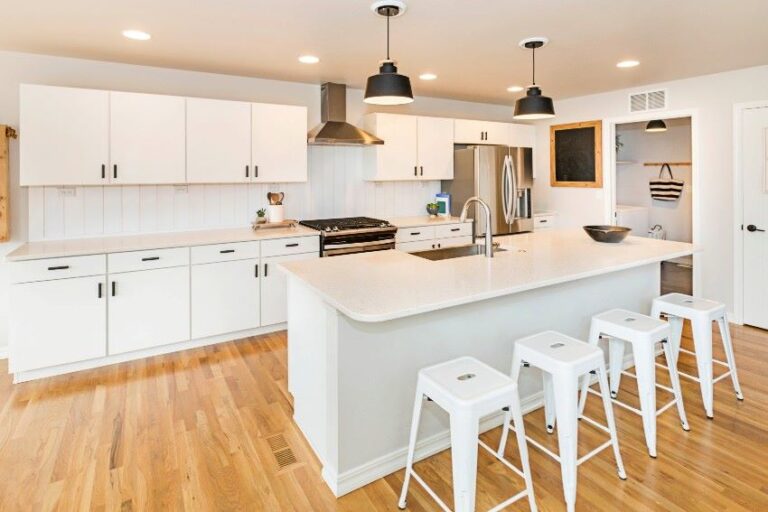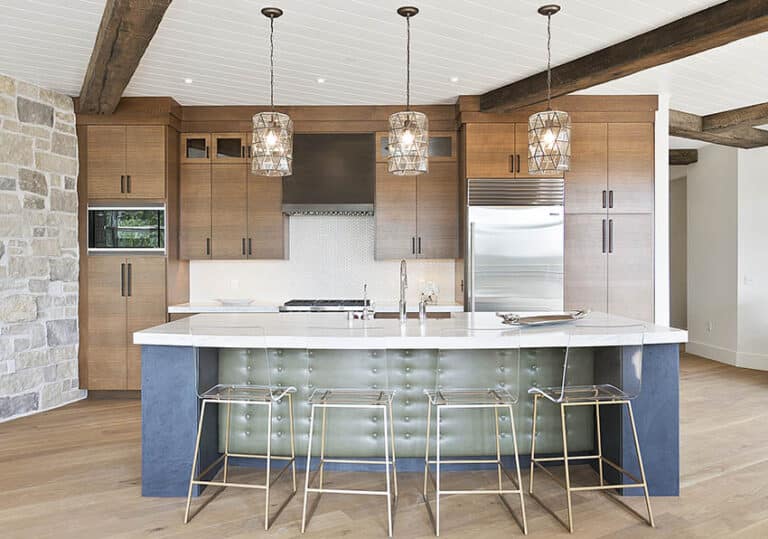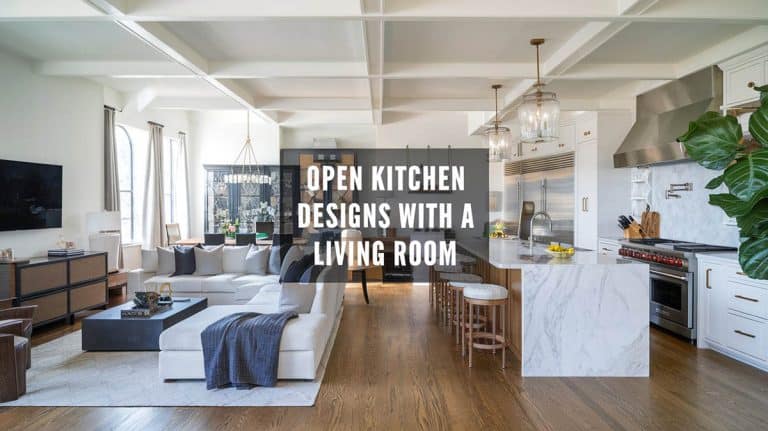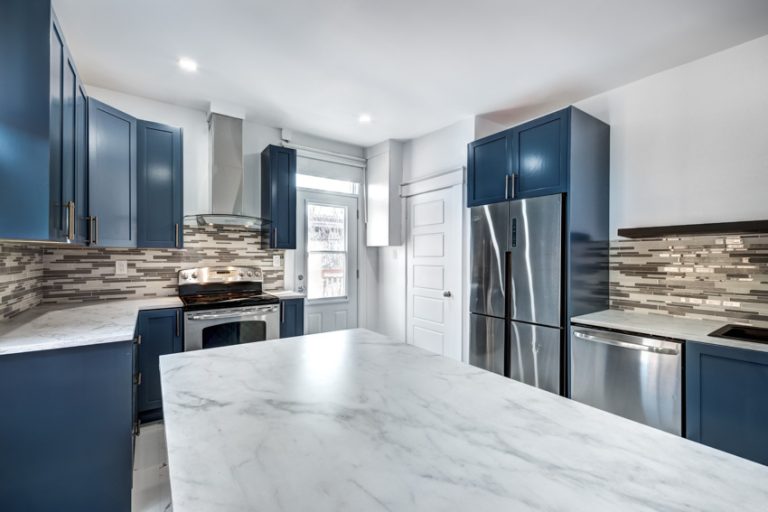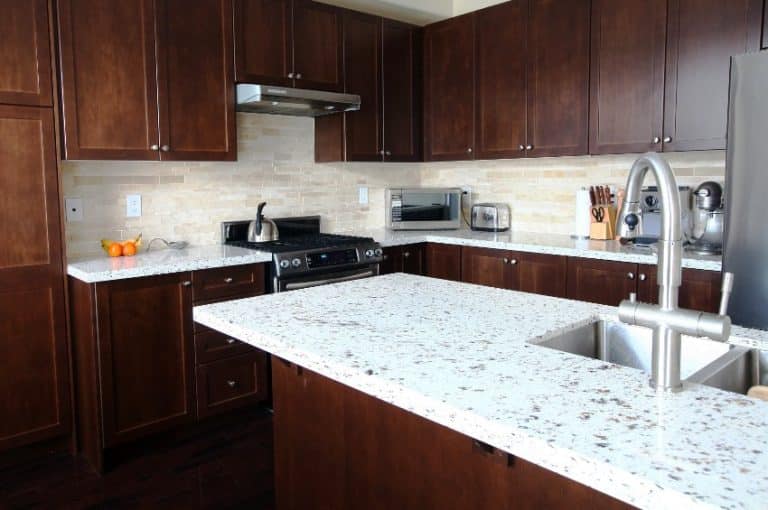Laminate Cabinets Vs Wood (Types & Designs)
This comparison of laminate cabinets vs wood shares the different types of wood & laminate designs, durability, cost, and differences in appearance & maintenance.
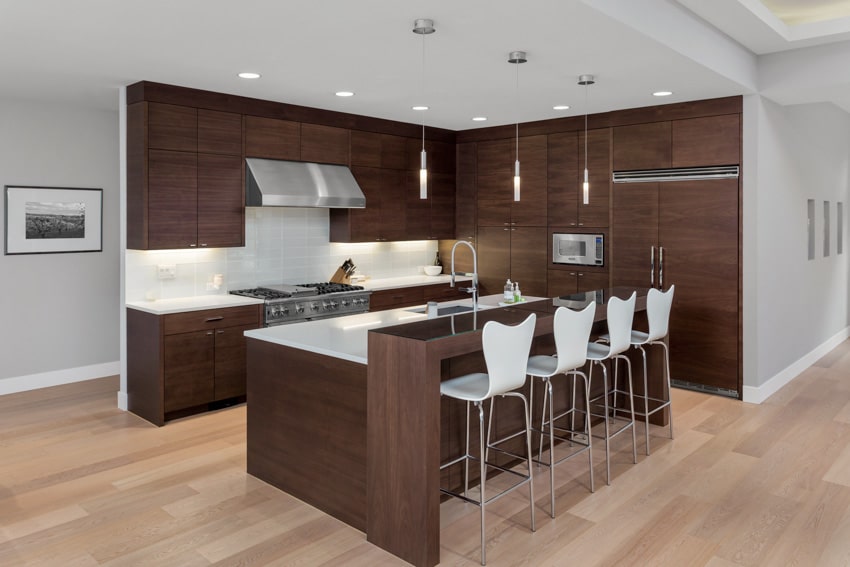
Since time immemorial, wood has always been a preferred material when it comes to furniture. The organic material showcases alluring textures and colors on every surface.
With our natural affinity towards nature, wooden cabinets, from classic profiles to the modern aesthetic, remain a popular option compared to industrial-made materials. Meanwhile, with the advancement of the manufacturing process, we see a tick in the popularity of engineered wood rivaling natural materials.
Laminate cabinets simulate the look and sometimes even feel like real wood and are the perfect alternative for homeowners who love the look of wood who but are looking for an affordable option. Learn more about the differences between laminate and wood cabinets for the next cabinet renovation and installation.
What Are Laminated Cabinets?
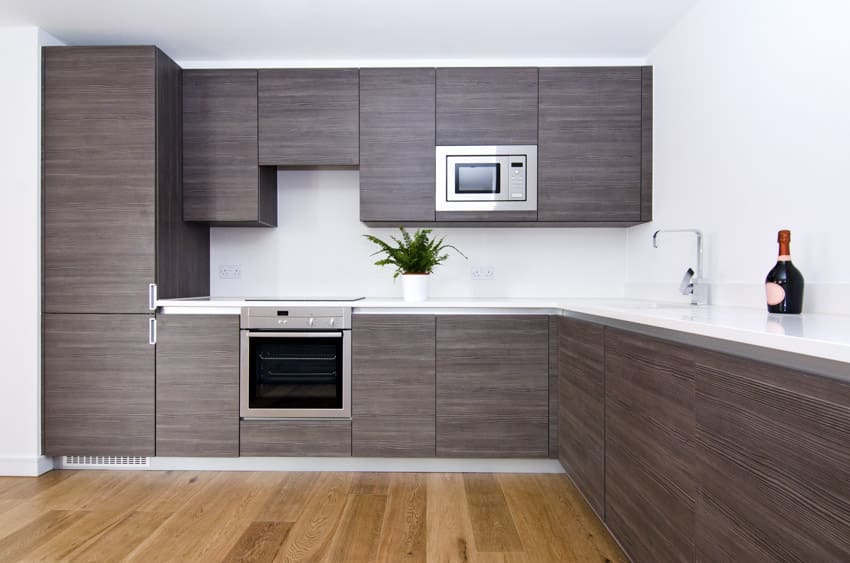
From the name itself, laminate cabinets are engineered wood assembled using laminate wood, and like other types of engineered wood, laminate wood composes of veneers. In the furniture industry, laminate wood is also called HPL or High-Pressure Laminate.
The most popular laminated storage units are usually made from MDF or medium-density fiberboard or particleboard, where a laminated layer provides protection for the cabinet’s surface. The standard thickness of laminate wood made for furniture is .8 mm and can range from .6mm – 1.2mm depending on the quality and usage.
Laminated wood composed of wood veneers is glued together in a parallel direction. Defining its structural integrity, this material has a core board, a very durable and dense inner layer usually made from compressed wood fiber. The usual density for core boards ranges from 750 – 880 kg/m3.
Sandwiching the core board is the decorative layer and the melamine wear layer. The decorative layer, as the name implies, provides the simulated woodlike color and graining and is protected by the melamine wear layer, which is the final layer on top of the wood that protects it from stains, fading, and scratches.
High-quality laminates usually have an aluminum oxide integrated into the melamine wear layer to further increase the toughness of the material.
Since laminate cabinets are made from fabricated materials, they can come in various sizes and designs. Knots and other defects typically found in solid wood cabinets are not present in laminate cabinets, thus giving them a more stable and uniform composition.
Laminate Cabinet Design

Laminate cabinet designs suit well in contemporary and modern interiors, which come in a wide range of designs and configurations.
However, manufacturers that provide traditional profiles are also available. High-end laminate cabinets integrate antibacterial and heat-resistant properties.
Pair your laminate base storage units with quartz countertops, and you get an elegant-looking center island that can pass off as a pricey ensemble.
Here’s some of the different laminate cabinet style variations:
High-Pressure Laminate (HPL): This is considered the most durable type of laminate material, and it is made of a very hard and durable surface that can resist denting and staining. Laminated wood made from HPL is usually used in commercial and industrial cabinets.
Thermofoil: Thermofoil is fast becoming a popular choice as it is an affordable and easy-to-maintain option that simulates the look of timber grain. This type of laminate is made from a vinyl material that is heated and wrapped around a particleboard or MDF (medium-density fiberboard) substrate.
Laminate Veneer: This laminate is made from a thin layer of wood applied to a particleboard or MDF substrate. See pictures of veneer kitchen cabinets here.
Acrylic Laminate: This type of laminate is made from a plastic material that is applied to a substrate. It has that contemporary look and often comes in a glossy finish. For a more modern appearance, acrylic laminate cupboards are a great option.
3D Laminate: This type of laminate is made from a process that adds a 3D texture to the surface of the laminate, making it look more like natural wood or stone.
What Are Wood Cabinets?
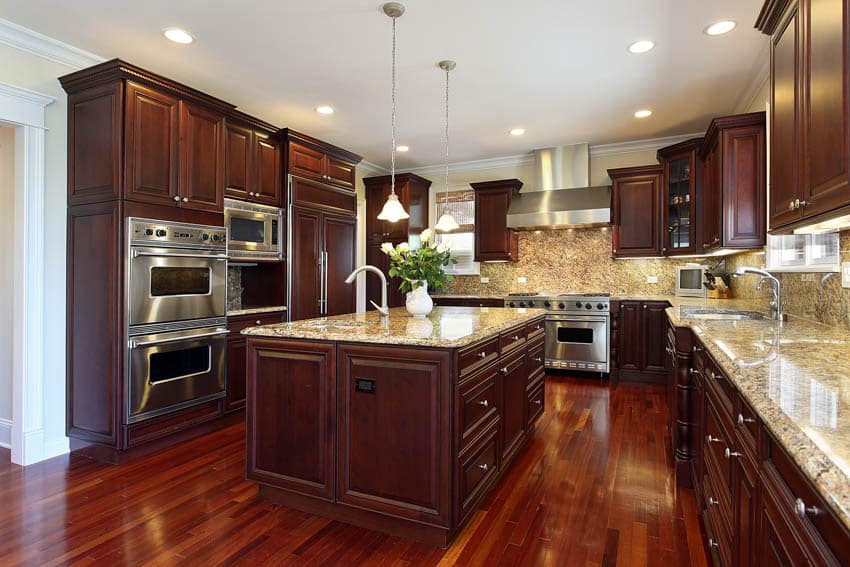
Wooden cabinets are made from solid natural lumber that can be crafted by hand or mass-produced by machine manufacturing. The remarkable strength of wooden cabinets makes them a favored material.
The average service life of wood cabinets can last 40 to 80 years. Common species preferred for cabinetry are oak, maple, mahogany, hickory, ash, cedar, pine, cherry, birch, and alder.
Since these cabinets are made from natural wood, every cabinet design is unique when it comes to texture and graining. This unique appearance and longevity, like wooden floors, can potentially increase a property’s value over time.
Wood Cabinet Design

There is a plethora of design options to choose from when it comes to wooden cabinetry, both bespoke and factory-assembled. The design depends on the main function of wood cabinets; for instance, cabinets made from hardwood are made to withstand heavy usage.
Hardwood: Cabinets made from hardwood, such as oak, maple, and cherry, are known for their durability and natural beauty. Hardwood cabinets can be resurfaced, finished, and stained periodically to maintain or change their appearance.
A variety of stains in finishes are available to improve the color and texture of hardwood cupboards. These storage units are also preferred for the kitchen and other wet areas as they have more stable material.
Softwood: Those made from softwood, such as pine and cedar, are also popular. They are less expensive and have a rustic, natural appearance.
Bespoke or Custom-made: Custom solid wood kitchen cabinets can be made from any type of wood and are built to the specific dimensions and design of a room. Custom-made cabinetry is crafted by skilled carpenters, adding the cost, and are a long time to make compared to laminates.
Unfinished: These types of cabinets come without any surface finish. The paint and stain depend on the customer and are less expensive than a fully finished wooden cabinet.
Reclaimed wood: A trending option for hardwood cabinetry is that they are made from reclaimed wood, meaning the material used is salvaged from old buildings, barns, or other structures.
Cabinets made from reclaimed wood showcase a unique vintage look and usually leave a patina finish (depending on the species).
Laminate Cabinetry Vs Wood Durability

Solid wood is perceived to be more durable than its synthetic counterpart, but studies have shown that high-quality laminate wood is 13% to 43% more durable. Laminates have also performed better than natural hardwood in malleability and flexural strength.
However, when laminates are fabricated as furniture, such as a cabinet, problems occur when edges or corners lift over time due to humidity or blunt impacts during usage. Moisture and water can seep through these openings, causing further damage to the laminate cabinet.
Moreover, laminate cabinets that are low to mid-priced typically include particleboard shelves and jambs. Particleboard is less durable compared to a wooden cabinet with the usual plywood shelving and door jambs, which are more robust than particle boards.
How Long Does Laminated Cabinetry Last Compared To Wood?
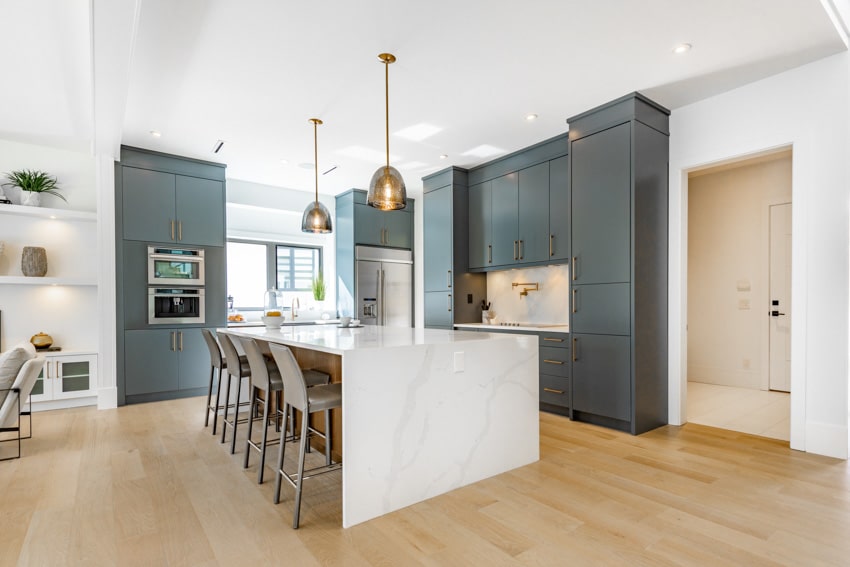
The longevity of the two materials depends on factors such as quality, function, and maintenance. One of the downsides of laminates is that the edges and corners can lift easily, caused by humidity and damage due to prolonged use.
While laminates typically can resist dents and scratches, the synthetic material can still receive minor damage. These small indents can open up the protective layer and are exacerbated by water and moisture.
Stagnant water on the surface can also warp off laminated cabinetry. Solid wood, on the other hand, can be sanded down typically every 10 to 20 years, removing visible dents or scratches. Moreover, some species are virtually waterproof and have natural oils that prevent water or moisture from seeping through.
Engineered Wood Cabinetry Vs Wood Cost
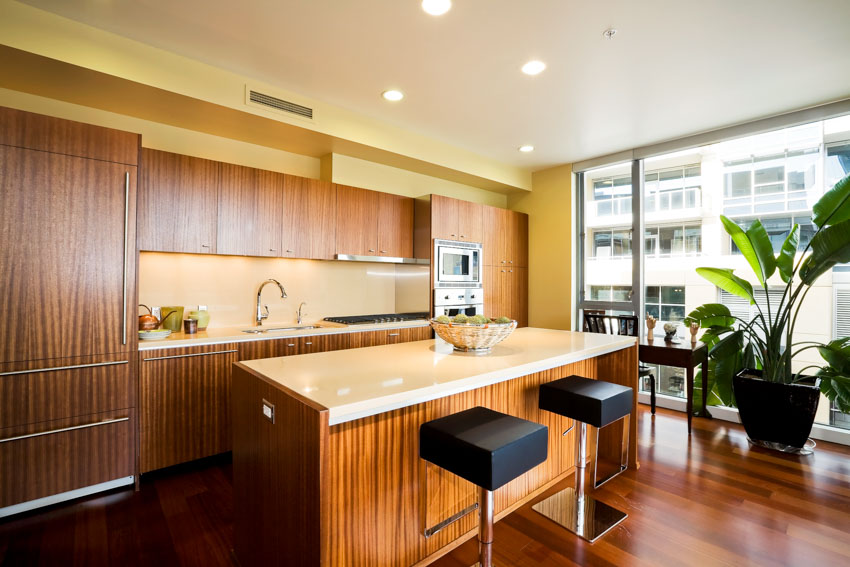
The price usually determines whether laminate or wood materials are the best options. With less upfront costs, a laminated cabinet is a more viable option as you get the natural aesthetic of wood. In addition, transportation and assembly costs are lower with laminated ones compared to solid hardwood cabinetry. However, exotic hardwood variations are also available with laminated designs.
However, while laminated storage units come with a lower price point, a solid hardwood cabinet is considered cost-effective as the furniture has a longer service life. Factors that can affect the price of these units include hardwood species, wood quality, and whether it is customized, preassembled, or comes from a machine-manufactured source.
Most of the cost of storage units made of hardwood comes mainly from the materials used. Hardwood can cost around $6 to $12 per square foot, with fewer installation costs. Exotic lumber costs more than locally grown species. Meanwhile, laminates range from $0.70 to $2 per square foot with fewer installation costs. It’s cost will also depend on the quality of the print layer.
Breakdown of Costs:
Hardwood Cabinetry
• Labor and Materials: Average cost is from $150 to $700 per linear foot
• Material: Average at $6 to $12 per square feet
• Refinishing Costs: $3 to $8 per square foot
Framed cabinetry also cost more than frameless cabinets. The average cost of framed ones cost around $5,000 to $20,000 or more. On the other hand, the frameless variety costs $6,000 to $30,000 or more.
Laminated Wood Cabinetry
• Labor and Materials: From $50 to $200 per linear foot
• Material: Average at $.70 to $2 per square foot
• Refacing: $80 to $100 per linear foot
Differences Between Laminate And Wood Surfaces
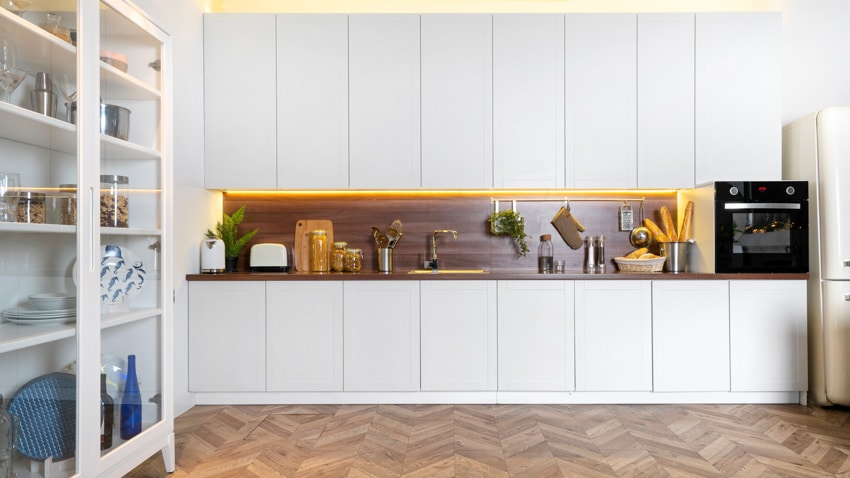
Appearance: Natural wood cabinetry still looks more natural compared to its synthetic counterparts, as natural variations, defects, and coloring are richer and tend to look warmer. Laminate (HPL) storage units usually have unusual uniform graining, and colors look more muted compared to their natural alternative.
Aesthetics and Psychological Impact: A study highlights that while laminated wood is made to simulate the look of natural wood, it lacks the stress-reducing effects of natural lumber. Natural wood also showcases a warmer and cozier aesthetic, while laminates are perceived as modern and contemporary.
Cost: Laminated wood is significantly more affordable than solid hardwood. Other factors affecting the price of laminated and solid wood are the brand and manufacturer.
Service Life: Due to the possible defects, particularly on the edges and corners of laminated cabinetry, their service life can range from 15 to 30 years, while those made of solid timber can last from 30 to 80 years, depending on the lumber species.
Installation: With a lighter mass and a wide range of prefabricated parts, laminated cabinetry is easier to install. Additional treatments and preparation are also needed for natural wood.
For instance, placing the solid lumber into the room where the cabinets are to be installed helps the wood fibers to settle, preventing warping or shrinking in the future.
Moisture resistance: Natural wood can warp, split, or rot if exposed to moisture for prolonged periods. On the other hand, laminates are more resistant to moisture and less likely to be damaged by spills or humidity.
Environmental Impact: A great advantage of solid hardwood over laminates is that the material can be used and recycled. The biodegradable properties of nature also make it easier to dispose of.
Some laminated cabinetry can be recycled depending on the main contents. Glue and other chemicals used in the manufacturing process can also potentially release harmful fumes in an indoor setting over time.
Maintenance: The synthetic top layer of HPL can withstand dents and scratches, is virtually waterproof, and can usually take many cleaning agents. Simply wiping the laminated cupboards and drawers with a damp cloth can remove stains and accumulated debris.
No need for refinishing or sanding down the surface of HPL cabinetry. Storage units made of solid timber are easy to clean and relatively easy to maintain. Furthermore, touching up the surface with wax or polish can help prevent damage.
Is It Worth Buying HPL Cabinets Or Wood?
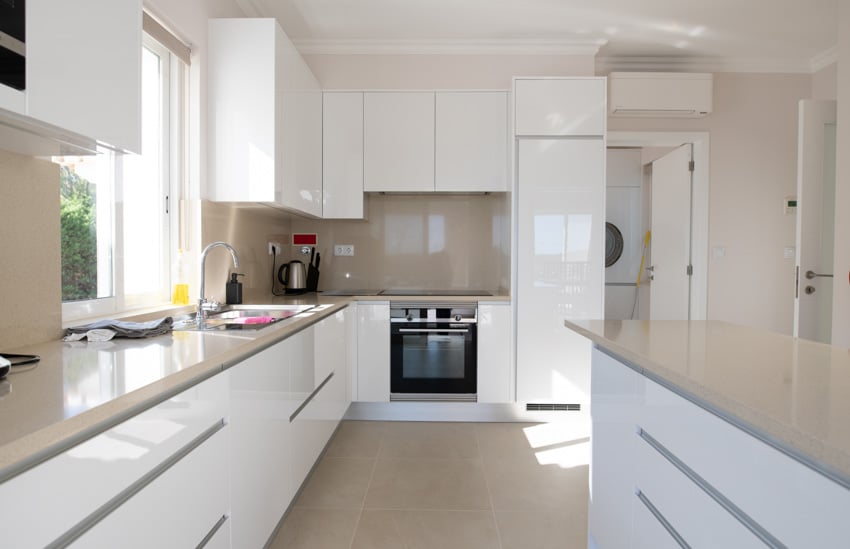
It depends mainly on factors such as length of tenure, budget, and other priorities. Solid, wooden pieces are a sound investment for homeowners looking for sturdier storage furniture. For potential buyers, wooden units are also preferred over engineered ones, especially in kitchens.
They can appreciate over time, especially when these are made from exotic or hard-to-source timber species. On the other hand, the laminated ones are a practical choice due to budget and time constraints.
When storage units need to be installed quickly, the laminated types are a more viable choice. For temporary tenure, such storage units are also a practical choice, as they are easier to assemble or dismantle when needed.
See more related content in our article about pressed wood cabinets on this page.

